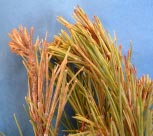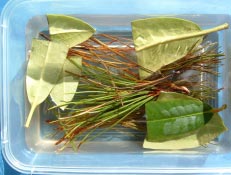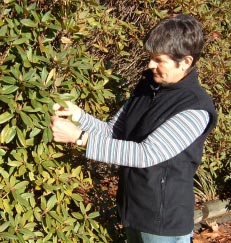PESTS AND DISEASES OF FORESTRY IN NEW ZEALAND
Diagnostics: Screening for Phytophthora in pine needles
Scion is the leading provider of forest-related knowledge in New Zealand
Formerly known as the Forest Research Institute, Scion has been a leader in research relating to forest health for over 50 years. The Rotorua-based Crown Research Institute continues to provide science that will protect all forests from damage caused by insect pests, pathogens and weeds. The information presented below arises from these research activities.
From Forest Health News 184, May 2008.

Daño Foliar del Pino (DFP) is a newly described disease of Pinus radiata foliage in Chile where there is widespread damage to plantation trees. In October 2007, Scion pathologists Lindsay Bulman and Rebecca Ganley visited Chile where they gained a first hand understanding of the symptoms of DFP (FH News 179, December 2007). Also in October 2007, Mike Wingfield, a forest pathologist from the Forestry and Agricultural Biotechnology Institute in South Africa who was investigating the disorder, announced that DFP was associated with a new species of Phytophthora, now called Phytophthora pinifolia. This was thought to be the first occurrence of a Phytophthora associated with diseased needles and shoots of a Pinus species.
As a result of these findings, screening of New Zealand P. radiata needles or branch samples showing banding, discolouration or resinosus for Phytophthora species is now carried out routinely in the pathology diagnostic lab at Scion. This is primarily to ensure that P. pinifolia is not present in New Zealand and also to allow early detection of an incursion. As Phytophthora species are notoriously difficult to isolate in pure culture, and colonies are so slow-growing that they are readily overgrown by other fungi on general growth media, several special detection methods are used.
In the first method, suspect material is surface sterilised and placed onto a specialised Phytophthora medium in Petri dishes. These dishes are then incubated and monitored for 25 days. Any growth on the dishes is subcultured for further examination.

The second method of testing for Phytophthora relies on the fact that these pathogens have spores that are able to swim in water. Samples are placed in clean water in a container. Clean rhododendron leaves are added to the water to act as bait for any Phytophthora spores released from the pine material. If after a week or more the rhododendron leaves become infected with Phytophthora, the leaves develop brown spots which can be cut out and placed on the specialised Phytophthora medium. If a Phytophthora grows out of the rhododendron leaves onto the medium, we have succeeded.
Once clean cultures of Phytophthora have been obtained from one of the methods described above, they are examined morphologically. This involves transfer of colonies through a series of solid and liquid media in order to induce the formation of sporulating structures; a process that, depending on the species, may take several weeks. In addition isolates will be prepared for the extraction of DNA so that a section of the genome can be sequenced and a molecular identification made. The results from the two processes are then considered together as isolate variation means that an immediate answer is often not achievable.
From October 2007 to June 2008, more than 20 radiata pine samples sent into the Scion lab as part of routine forest surveillance have been tested for Phytophthora. The number of samples is likely to increase during the coming winter and spring months as this is typically the period when many needle diseases are most apparent. At this stage, DFP and P. pinifolia have not been found in New Zealand.
As a result of these studies of the fungi growing on radiata needles and the use of rhododendron leaves for baiting, several unusual species of fungi have been uncovered. Isolates of some fungi may appear very similar to Phytophthora when the colonies are very young but continued inspection and molecular evidence reveals they are not.
Screening of radiata needles and branches for Phytophthora species will continue in the Scion diagnostics lab as part of our routine sampling procedures. A field identification guide for DFP can be found at:
http://www.ensisjv.com/NewsEventsandPublications/Publication/ResearchPublication/ForestHealthandProtectionBulletins/tabid/
314/Default.aspx (FBRC report here PDF 180.80 kB)
Anna Hopkins
SURPRISE FIND FROM PHYTOPHTHORA BAITING
Forest Health News 185, June 2008.
In the last issue of Forest Health News (FH News 184, May 2008) the baiting process for isolating species of Phytophthora was described. This technique is used to extract micro-organisms that may be present in the host material but are difficult to isolate by conventional methods, and takes advantage of the fact that these organisms produce motile spores that swim in water. Techniques like this, aimed at a specific genus or group of organisms, sometimes yield unexpected results. We recently reported a fungus that is new to New Zealand from this process. The fungus was obtained after Pinus radiata needles had been floated in distilled water and baited with Rhododendron catawbiense leaves. Examination of young cultures showed no distinctive identifying features and so the fungus was put through the molecular identification process. DNA was extracted, the ITS region sequenced and an international gene database search gave a match with Pestalotiopsis clavispora, a fungus not known to occur in New Zealand. Morphological examination confirmed the identification.

leaves.
The problem was – what was the host? Had it come from the radiata pine needles which were the target host plant in the whole procedure – or was it the rhododendron leaves? Pestalotiopsis clavispora had not been recorded on either of these hosts before anywhere in the world. What was the location of the record? Was it Southland or the Bay of Plenty? The pine needles came from Tiwai Point at Bluff and were collected as part of a high risk site survey. The rhododendron leaves were collected from a specimen tree on the Scion campus in Rotorua.
Further specimens from both plants were collected, surface sterilised, and placed directly onto a general growth medium. Pestalotiopsis clavispora was not isolated from the P. radiata needles but was the sole fungus obtained from the Rhododendron leaves. The leaves were free of blemishes and as there are no published records of P. clavispora as a plant pathogen the fungus appears to be a non-pathogenic endophyte. Pestalotiopsis species are typically saprophytic or associated with relatively minor leaf spotting so it is unlikely that this new Pestaliopsis will ever be associated with much damage to Rhododendron species. So what began with a simple baiting for needle pathogens on radiata pine, ended with a fungus that is new to New Zealand on a totally different host!
Margaret Dick & Anna Hopkins
This information is intended for general interest only. It is not intended to be a substitute for specific specialist advice on any matter and should not be relied on for that purpose. Scion will not be liable for any direct, indirect, incidental, special, consequential or exemplary damages, loss of profits, or any other intangible losses that result from using the information provided on this site.
(Scion is the trading name of the New Zealand Forest Research Institute Limited.)

 Farm Forestry New Zealand
Farm Forestry New Zealand

